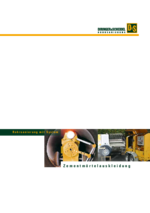The product
The cement mortar lining of drinking water pipes in accordance with DVGW Code of Practice W 343 by specialist companies certified in accordance with R4 is an economical corrosion protection method for the restoration of pipes made of various materials in water distribution networks, the functional efficiency of which has been impaired by incrustations and corrosion. The centrifugal mortar is manufactured from cement according to DIN 1164, quartz sand with a maximum core size of 1 mm and water of drinking water quality.
The field of application
State-of-the-art equipment technology makes it possible to line pipelines with nominal diameters from 80 mm to 3,000 mm with steel, grey cast iron, ductile cast iron and other materials. The process serves to restore the internal protection of the old pipe and promotes its hydraulic properties. Corrosion damage is prevented and incrustations are avoided.
The installation
After the pipe section to be rehabilitated has been taken out of service and cleaned, the coating material is thrown against the pipe wall by a rapidly rotating centrifugal head. For large pipes from DN 600, electrically driven, pneumatic and self-propelled centrifugal machines can be used. In the small pipe range from DN 80 to DN 600, compressed air-driven motors are usually used for lining.
The cement mortar is pumped from a mixing tank via a mortar hose into the centrifugal head. The mortar can be evenly distributed by means of radially arranged, comb-like plates on the outside. A constant pulling speed ensures an even and optimum layer thickness. The mortar sets within 24 to 26 hours. The pipeline can then be filled and put into operation.
![[Translate to English:] Diringer & Scheidel Rohr [Translate to English:] Logo Diringer & Scheidel Rohr](/fileadmin/media/logos/DuS_Rohr_GmbH_u_Co_KG.svg)
